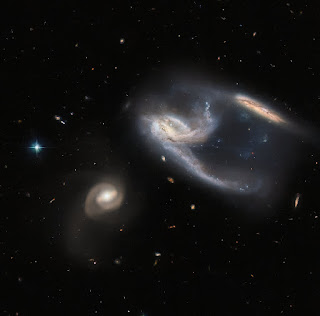 Using the Hubble Telescope's Advanced Camera (ACS) and Wide Field Camera 3 (WFC3), a cluster of three galaxies was imaged. As shown in the image, the two galaxies have merged, scientists say, just as the two galaxies in the upper right appear to be interacting with each other, it is, in fact, stars. Its long trails and the gas spreading from both of them gives the impression that these two have just collided with each other very fast. In the lower left of the image is the bowling-ball-sized galaxy.
Using the Hubble Telescope's Advanced Camera (ACS) and Wide Field Camera 3 (WFC3), a cluster of three galaxies was imaged. As shown in the image, the two galaxies have merged, scientists say, just as the two galaxies in the upper right appear to be interacting with each other, it is, in fact, stars. Its long trails and the gas spreading from both of them gives the impression that these two have just collided with each other very fast. In the lower left of the image is the bowling-ball-sized galaxy.Scientists say that the interaction between two galaxies occurs over a long time period, however, rarely will the galaxies collide with each other. These galaxies are so close to each other in space that they form a cluster, which scientists have named NGC 7764A. The mass between these galaxies has caused the formation of a shape at the end that, from the point of view of our solar system, resembles the starship known as the USS Enterprise from Star Trek.
This group of galaxies, known as NGC 7764A, is located about 425 million light-years from Earth in the constellation Phoenix. The NGC 7764A cluster is made up of three galaxies, including NGC 7764A1, NGC 7764A2 and NGC 7764A3, the individual transformation of the three galaxies, a phenomenon rarely seen.
NGC 7764 Galaxy NGC 7764A1, completely different from NGC 7764A2 which sits in the sky about a moon's distance (as seen from Earth). Scientists say that this random naming makes more sense when we consider that many catalogs for tracking celestial objects were compiled well over 100 years ago. Modern techniques have greatly facilitated the standardization of scientific terminology, as things continue to be discovered, they are named after their discoverer, and many celestial objects have many different names, Or there may be names that are so similar to the names of other objects that they cause confusion.


Comments